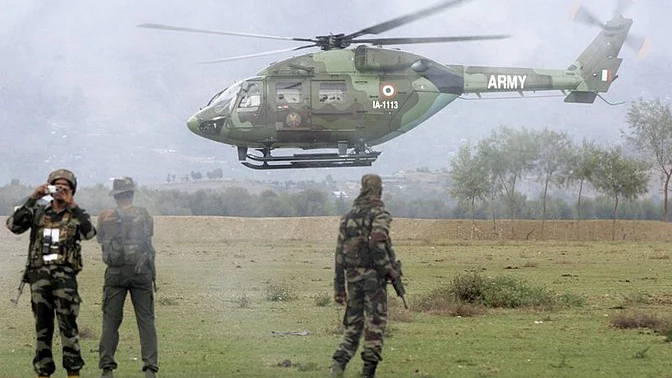Long before first light broke over Jorhat, six Mi-17 helicopters took off carrying 120 men from the army’s 21 Special Forces battalion. The helicopters flew low, reaching Rangapahar, in Nagaland’s Dimapur, in about 40 minutes.
The men, most in their mid-20s, in camouflaged full and half-sleeves T shirts, ammunition pouches strapped at their waists, with blackened faces and carrying an assortment of lethal weapons like AK-47 and grenade launchers and compact communication equipments, quickly grouped together for a final briefing by their commanding officer under the auspices of the army’s 3rd Corps.
Although they were put through an intensive briefing session in Jorhat, they were reminded of the targets, two rebel camps in Myanmar’s Sagaing Division just across Chandel district in Manipur, where on June 4, 18 soldiers belonging to the 6th Dogra regiment were killed in an ambush by insurgents belong to the Meitei Kanglei Yawol Kanna Lup (KYKL) and National Socialist Council of Nagaland (Khaplang), that had to be neutralised. One of the targets was Thantapin, just south of Tamu.
Strikes in Two Camps in Myanmar
Two days before the operation got underway an unmanned aerial vehicle (UAVs) moved many miles up in the sky and positioned itself over the Sagaing Division to take photographs from its powerful cameras of the insurgent camps surrounded by jagged hillocks and dense foliage.
A day after the Chandel ambush, Indian security agencies tracked down two former NSCN(K) kilonsers (ministers) P Tikhak and Y Wangtin Naga who had been “expelled” by their parent outfit led by S S Khaplang, a Burmese Naga, who in March abrogated a 14-year ceasefire with the Indian government. Tikhak (from Arunachal Pradesh) and Wangtin (from Nagaland) who had opposed Khaplang’s decision to end the ceasefire, were roped in to provide specific information on the location of the NSCN(K)’s camps inside Myanmar.
The helicopters flew over Ukhrul district before slipping across the India-Myanmar border after which it did not take much time to locate the two camps where the perpetrators of the Chandel ambush had taken shelter following their operation. Before zeroing in on the camps, the helicopters broke formation with three engaging the Thantapin camp while the rest circled around the other camp, Ongia, east of Nagaland inside Myanmar.
As the engines and rotors roared, the commandos opened up with their machine guns and fired rocket propelled grenades. The impact on the ground was devastating: the camp huts burned as the rebels below, some dressed in civilian clothes while others in shabby olive green uniforms, ran for cover. Encircled by a hail of fire, several of them fell. Army reports after the operation ended suggested that about 15 insurgents were killed.
A second group of commandos who had been rappelled down moved through the dense jungles to encircle the two camps to verify the impact of the attack from the air.
Drones, Former Khaplang Comrades Helped?
A day after the army’s “surgical operation”, the NSCN(K) on June 10 disputed the claims made by the Additional Director General of Military Operations, claiming in a statement that “the entire reports were efforts by the Indian Army to “salvage their reputation” after the Chandel ambush. Denying that the outfit suffered any casualty, the statement said that all its cadres were “peacefully paying” respect at the funeral services of their comrades who died in the June 4 ambush. The NSCN(K) has “challenged” the army to display the bodies of the insurgents supposedly killed in the strike.
Did the Indian commandos hit NSCN(K)’s transit camps, which explains why the cadres stationed there did not retaliate? Typically close to the India-Myanmar border, the transit camps usually cater to the heavily armed cadres with rations and house large contingents whenever they on their way to conduct operations in India.
Whether the locations targeted were full-fledged camps or transit camps, the message has certainly gone to an aging Khaplang that the Indian army will now undertake special operations in the Myanmar side of the border. Khaplang, who is reported to be ailing and is convalescing in a Yangon hospital – which could not have happened without the full knowledge of the Myanmarese army – continues to command a large number of rebels, who are led by ‘General’ Niki Sumi, even in the face of two ruptures within the organisation over the past five years.
Why is Myanmar Silent?
The first break took place in 2010 when Khole, who was the commander-in-chief, and Khitovi Zimomi, the outfit’s general secretary, broke away. The second fracture took place in the last week of March this year when Tikhak and Wangtin, both moderates, quit the rebel outfit. The NSCN(K)’s decision to end the ceasefire was the result of the on-going power struggle encouraged in good measure by Indian intelligence.
Curiously, more than 24 hours after the Indian army attack, the Myanmar authorities have not reacted to the operation although on June 9 the ADGMO claimed that Yangon had been informed the military strike was launched.
Intelligence sources said that Yangon’s silence could be because of the Myanmarese military’s own ceasefire with the NSCN(K), although leaders of Myanmar’s armed ethnic groups agreed to a draft countrywide ceasefire agreement on June 9. The NSCN(K)’s name does not figure in the list of 16 Burmese insurgent groups (Khaplang is a Burmese Naga) who accepted the amendments to the draft ceasefire pact.
To know everything about the Myanmar Operation, click here.
(At The Quint, we question everything. Play an active role in shaping our journalism by becoming a member today.)
